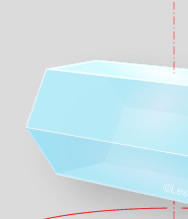
OPOD
What's New
Rays & Shadows
Water Droplets
Rainbows
Ice Halos
Contents
Crystals
Crystals & Halos
Columns & Plates
Orientations
Plate
Column
Parry
Lowitz
Random
Face numbers
Real Crystals
Diamond Dust
Pyramidal
Frequent Halos
Infrequent Halos
Multiple Displays
Other Worlds
Observing Halos
HaloSim
High Atmosphere
Links & Resources
Search - Index
123456789012345678
| Parry Orientation & Parry Arcs |
|
If
the near perfect orientation of column crystals sounds improbable,
that of Parry oriented crystals must seem wildly so. The long
crystal c axis is horizontal AND so are two of the prism side
faces. The only degree of freedom is the
ability of the crystal to take all rotational positions about
a vertical axis passing through the crystal centre and perpendicular
to the two horizontal faces. Rays passing through two prism side faces with a wedge of 60° produce sunvex and suncave Parry arcs (column orientations make tangent arcs). These are the most common Parry arcs. Rays travelling between a side face and a vertical end face - wedge of 90° - make the exceeding rare Parry supralateral (Tape) and infralateral arcs. Rays passing between the horizontal and vertical faces make the circumzenithal and circumhorizon arcs much more commonly produced by plate crystals. Reflection from a sloping prism face gives a very rare helic (heliac)
arc until recently only seen in the Antarctic. |
 |
 |
 |
 |
 |
 |
| suncave Parry and upper tangent arcs |
sunvex
and suncave Parry arcs |
Parry supralateral (Tape) arc | Parry infralateral | helic arc |
|


